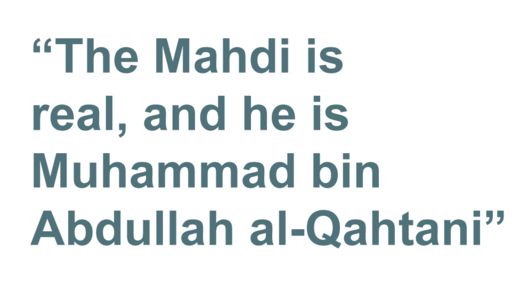[ by Charles Cameron — as so often, religious analysis reveals a passionate motivational driver which can help us understand a national security threat — in this case not just from Iran ]
.

Yes, that’s Soleiman embraced in death by Imam Husayn ibn Ali, the great martyr of Karbala
D’oh!
**
As we process the death of Iranian Revolutionary Guard’s elite Quds Force commander, Maj Gen Qassem Soleimani by today’s US drone strike, it’s worth taking a look at religious aspects of the response to the death of an iconic figure, who is viewed in Iran as a “glorious martyr“.
Narges Bajoghli is an Assistant Professor at the Johns Hopkins School of Advanced International Studies {SAIS], and author of Iran Reframed” based on ten years of field research on the IRGC. She has a very pointed tweet which shows the illustration above, commenting:
More Art on Soleimani by Iran reg cultural ctrs. Imp to note dead Soleimani embraced by Imam Hussein. W/in Iran this circulating w text “Iran’s Rostam” (hero from Persian epic). Nat’lism + rel symbols to rally around flag internally, while image alone communicates to non-Iranian Shia.
Two points here — Martyrdom, and the tale of Sohrab and Rustum.
**
Martyrdom:
Martyrdom is a central motif in Shi’ite thinking, which centers on the Battle of Karbala in which a small contingent led by the Prophet’s grandson, Ali’s son Husayn was defeated and martyred by the much greater forces of Yazid, second of the Sunni Umayyad caliphs — conceptually, the founding moment for Shia separation from Sunni Islam.
The death of Husayn is mourned yearly on Ashura, the 10th day of Muharram, with the slogan:
Every Day Is Ashura and Every Land Is Karbala
Imam Husayn embracing Soleimani thus pouts him at the very heart of Shia maythology. There could hardly be a more emphatic invocation oa a current of religious thought underlying not just Iranian but all Shi’ite thinking>
Thus Iraq’s usually quietist Grand Ayatollah Sistani, hugely admired outside Iran, may well feel called to request the departure of all US troops from Iraq as a result — should this happen, it would be a great victory, in death, for Gen Soleimani.
For a Christian equivalent, think of the devout Catholic observance of the Stations of the Cross.
**
Rustum:
The tale of Sohrab and Rustum is an except from the Iranian national epic, the Shahnameh, “relating how the great warrior Rustum unknowingly slew his long-lost son Sohrab in single combat” —a tale which is even known to English readers in the version by poet Matthew Arnold:
But, with a grave mild voice, Sohrab replied:—
“Desire not that, my father! thou must live.
For some are born to do great deeds, and live,
As some are born to be obscured, and die.
Do thou the deeds I die too young to do,
And reap a second glory in thine age;
Thou art my father, and thy gain is mine.
But come! thou seest this great host of men
Which follow me; I pray thee, slay not these!
Let me entreat for them; what have they done?
They follow’d me, my hope, my fame, my star.
Let them all cross the Oxus back in peace.
But me thou must bear hence, not send with them,
But carry me with thee to Seistan,
And place me on a bed, and mourn for me,
Thou, and the snow-hair’d Zal, and all thy friends.
And thou must lay me in that lovely earth,
And heap a stately mound above my bones,
And plant a far-seen pillar over all.
That so the passing horseman on the waste
May see my tomb a great way off, and cry:
Sohrab, the mighty Rustum’s son, lies there,
Whom his great father did in ignorance kill!
And I be not forgotten in my grave.”
And, with a mournful voice, Rustum replied:—
“Fear not! as thou hast said, Sohrab, my son,
So shall it be; for I will burn my tents,
And quit the host, and bear thee hence with me,
And carry thee away to Seistan,
And place thee on a bed, and mourn for thee,
With the snow-headed Zal, and all my friends.
And I will lay thee in the lovely earth,
And heap a stately mound above thy bones,
And plant a far-seen pillar over all,
And men shall not forget thee in thy grave.
Soleimani, then, is drawn into an embrace by Huseyn, viewed as another Rustum, heroic Iranian icon — and on today’s Middle Eastern battlefields from Lebanon to Iraq a brilliant strategist and warrior..
**
Reflect, then, on this 2009 quote from Soleimani, to get a sense of the man as he regards his own role:
The war-front is mankind’s lost paradise. One type of paradise that is portrayed for mankind is streams, beautiful nymphs and greeneries. But there is another kind of paradise. … The war-front was the lost paradise of the human beings, indeed.
Isaac Chotiner describes him thus in the New Yorker:
If he had described himself, it would probably have been as the commander of Iran’s equivalent of CENTCOM, the regional commander of all of Iran’s operations — security, intelligence, military– outside of the Iranian border.
And to return to martyrdom:
The main [Iranian] news channels showed a live gathering at a mosque in Gilan Province, where the preacher reassured worshippers that “the best death is martyrdom for God” and that “great men prefer martyrdom to death by natural causes, cancer, accidents or old age”.
**
Recommended tweeting:
Vali Nasr, until recently dean of SAIS
Narges Bajoghli, SAIS Assistant Professor
Mohammad Ali Shabani, PhD Researcher at SOAS







